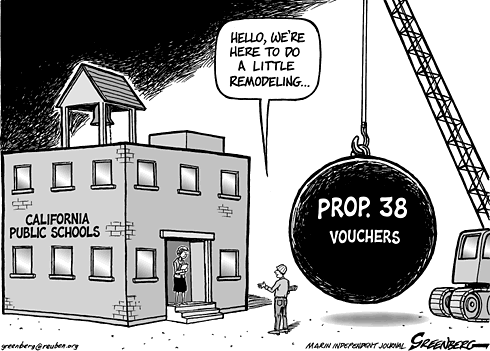School voucher
The education voucher is a document in which the state guarantees all or part of the payment of costs for school, university (education) or care. Student Accounts are a special form of education vouchers.
The classic voucher model of Milton Friedman
Milton Friedman argued for the first time in 1955 for an alternative education funding through the introduction of education vouchers. The education voucher has the following features:
The tax money no longer flows directly to the educational institutions, but in a roundabout way about the students or trainees ( in a general sense ). The apprentice or his guardian shall be issued a voucher, which he can apply for an education provider and pay for its services. The education voucher is issued in the name of the trainee and non-transferable. The trainees are the education voucher a freely selectable and state-recognized educational institution. This solves the voucher with the Treasury in exchange for money, with which they can pay their staff, space, and other material costs as part of a self-managed budget. All trainees receive a nationally defined basic value which is independent of parental income; this financing method takes the place of gratuitousness of state educational institutions and government direct subsidies to private institutions.
Production of educational opportunities and competition
The education voucher is according to its advocates a more effective economic contribution of the State on the implementation of civil rights dar. to education, the state does not fund more school (Object Promotion ), but the student ( subject support ). The revenues of the schools or other educational institutions depend on students to take and retain due to the choice of students and parents. The reputation of a school is eligible to compete for students and for teachers competent in a significant importance. Effective competition among educational institutions requires transparency in terms of quality and cost, a sufficient alternative supply and an adequate level of educational freedom in terms of educational objectives and educational methods. Schools should be intensified to a compelling educational approach to all its participants to seek an effective implementation of their concept and to effective marketing and media presence an educational consensus.
Whether a greater privatization of education, which could be held by a general use of education vouchers in the field of education, would make sense, is socially controversial. Proponents of a system that would build on education vouchers to see in such a system an incentive for schools to work more efficiently. Opponents of such a system see it as a trigger for greater social segregation.
The requirement to provide every school child and youth a place available, and the public interest in education, are a completely free market to some extent contradictory. According to studies, a school choice leads to a preference for those schools whose student bodies have a higher socioeconomic status, and with unrestricted freedom of choice results in a hierarchy of schools. There are also schools in a free competition strong incentives to take only achieving school. A student selection is for a school may economically attractive than an increase in the number of students, so that successful schools have little incentive to expand. At the same time is a closure of unsuccessful educational institutions, as would be required according to market principles, in the case of imminent supply shortages due to the compulsory school attendance, where appropriate very difficult.
What is the value of education vouchers it could go in the event of its general use in school education in Germany, show the cost of investigations to be provided every three years its Landtag of Baden- Württemberg government. Then cost in public schools an elementary school student, the municipalities ( in 2004) and the country (2005) together € 3,362, € 5,236, a chief disciple, a junior high school student € 4105 € 5132 and a high school student.
Children and young people are entitled to monthly 10 € to participate in the community in social and cultural life can up to the age of 18 years according to § 28 paragraph 7 SGB II. According to § 29 section 1 SGB II services for school and day care and relaxation, learning support and the budget for participation in social and cultural life can be provided through personalized vouchers or direct payments to providers.
Use of school vouchers
In the United States, many experiments have been conducted with school vouchers, where it was not about the introduction of a liberal order for the entire education system, but only to more equitable access for poorer populations to better schools. In the U.S., government subsidies to private schools because of the constitutional commandment of strict separation of church and state are not possible in Germany, however, 60 to 90 % of the costs are covered by government subsidies to the private schools of general education, in most provinces, even the per capita the student will be given. Recently, school evaluations have also revealed large differences in quality between public schools in the Anglo-Saxon countries and the desire of many parents awakened, to be able to send their child to another public school. About the school, which will visit the child, should not be decided at the apartment broker, has Tony Blair demands and canceled the school districts and school routes subsidized.
As part of the New York City School Voucher Experiment education vouchers were distributed to low-income families. With these coupons, they could be tuition and education at a private high school to buy their choice. Since there were more applicants than vouchers, had a lottery will be held to hand out the vouchers. The rest of the families, formed the control group. After four years, the voucher group and the control group were compared:
- For whites, Hispanics and Asians, there was no difference between the groups in the math performance and reading performance
- Black students from the voucher group cut in reading somewhat better than black students in the control group. The math benefits there was no difference.
Voucher experiments in Dayton, Milwaukee seem to confirm the result. Why not see many scientists educational vouchers as a suitable means to to improve the school performance of disadvantaged groups.
In Chile, education vouchers have been used widely since 1981 and have led to the creation of over 1,000 private schools. A study published in 2005 about the consequences of not pointing to an objective improvement of learning outcomes, but a clear separation of the student body.
Education vouchers of the Federal Employment Agency
The education voucher III is issued by the Federal Employment Agency, a worker or an unemployed certification that the conditions for the promotion of vocational training available in accordance with § 81 para 4 SGB. He is an assurance within the meaning of § 34 SGB X and thus a commitment to adopt a specific administrative act later. The education voucher is to be presented to the carrier selected by the employee training. This shall provide the education voucher Employment Agency before the start of the measure. Education vouchers are issued for a maximum validity of three months for the commencement of the training program. They can be regional and limited to specific educational goals.
On the promotion of vocational education by the Federal Employment Agency has no legal claim. Rather, it is a so-called discretionary power, the granting of which is within the discretion of the Authority. Basically, the output of an education voucher for reasons of cost by the federal agency become more and more restrictive. Alternatively, shorter training up to twelve weeks in duration than training program for the unemployed ( Germany ) can be promoted.
Who takes part in a sponsored training program, retain his rights to unemployment benefits. If at the beginning of the measure is entitled to unemployment benefits 30 days or less, this claim remains frozen during the action. If more than 30 days is to start the action entitled to unemployment benefits, the measure of the claim is reduced by one day for every two days, but at most reduced to 30 days. For holders of an education voucher, the cost for the course, required learning tools, work clothes, test pieces, legally prescribed or generally recognized interim and final exams as well as for the necessary aptitude are taken. If the participant must stay outside his place of residence, the cost of travel between home and educational institution may be reimbursed. Must stay of the participants away, he gets the cost of arrival and departure as well as the cost of a trip to the family or for a visit to the partner or child reimbursed once per month. This is a traveling allowance, which is 0.36 € per kilometer for the first ten, and for every additional kilometer 0,40 €.










